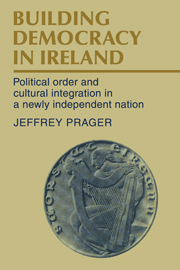 Building Democracy in Ireland
Building Democracy in Ireland Book contents
- Frontmatter
- Contents
- Preface
- Part 1 Democracy in Ireland: Theoretical and Empirical Problems
- Part 2 Patterns of Crisis Resolution in the Irish Free State, 1922–1932
- 4 The Army Mutiny and Normative Political Challenges
- 5 The Boundary Commission Crisis and the Development of Strategies of Political Efficacy
- 6 The Limits of Effective Rule: The Assassination of Kevin O'Higgins and Its Aftermath
- Part 3 The Character of Irish Democracy
- Notes
- References
- Index
6 - The Limits of Effective Rule: The Assassination of Kevin O'Higgins and Its Aftermath
Published online by Cambridge University Press: 25 October 2011
- Frontmatter
- Contents
- Preface
- Part 1 Democracy in Ireland: Theoretical and Empirical Problems
- Part 2 Patterns of Crisis Resolution in the Irish Free State, 1922–1932
- 4 The Army Mutiny and Normative Political Challenges
- 5 The Boundary Commission Crisis and the Development of Strategies of Political Efficacy
- 6 The Limits of Effective Rule: The Assassination of Kevin O'Higgins and Its Aftermath
- Part 3 The Character of Irish Democracy
- Notes
- References
- Index
Summary
Introduction: the changing political context
In July 1927, Kevin O'Higgins, vice president of the Executive Council and minister for justice, was fatally shot in a street outside of Dublin on his way to Sunday mass. He was one of the most outspoken, prominent, and competent members of Cosgrave's government and one of the chief architects of Cosgrave's program to secure social order in the Free State. He was hardly loved by the Republican forces; in his ferocious commitment to the Free State, he was strongly identified with the repressive side of Cosgrave's rule. His assassination rocked the government and the nation; because of his identification with the forces of order, his death demonstrated the ever-present specter of violence lurking just beneath the political surface. Although it was an isolated event for which no political or military group claimed credit or accepted responsibility, the assassination was widely interpreted, by government leaders and the population in general, as evidence of the persistence of physical force, however weak, and the dangers it posed for political stability.
This chapter examines the government's response; it was the response to the assassination, and not the act itself, I will argue, that constituted this third political crisis. For reasons that will be made clear, this was a crisis of the government's own making. In an important sense, the government took advantage of the assassination to complete the project it had created for itself in responding to the previous two crises.
- Type
- Chapter
- Information
- Building Democracy in IrelandPolitical Order and Cultural Integration in a Newly Independent Nation, pp. 160 - 182Publisher: Cambridge University PressPrint publication year: 1986


